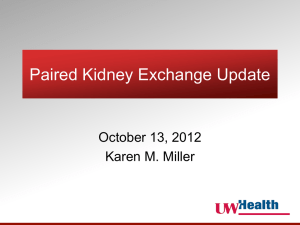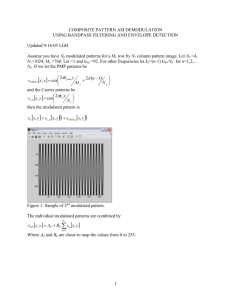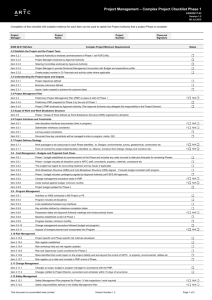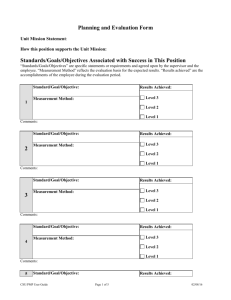Notes from the Field
advertisement
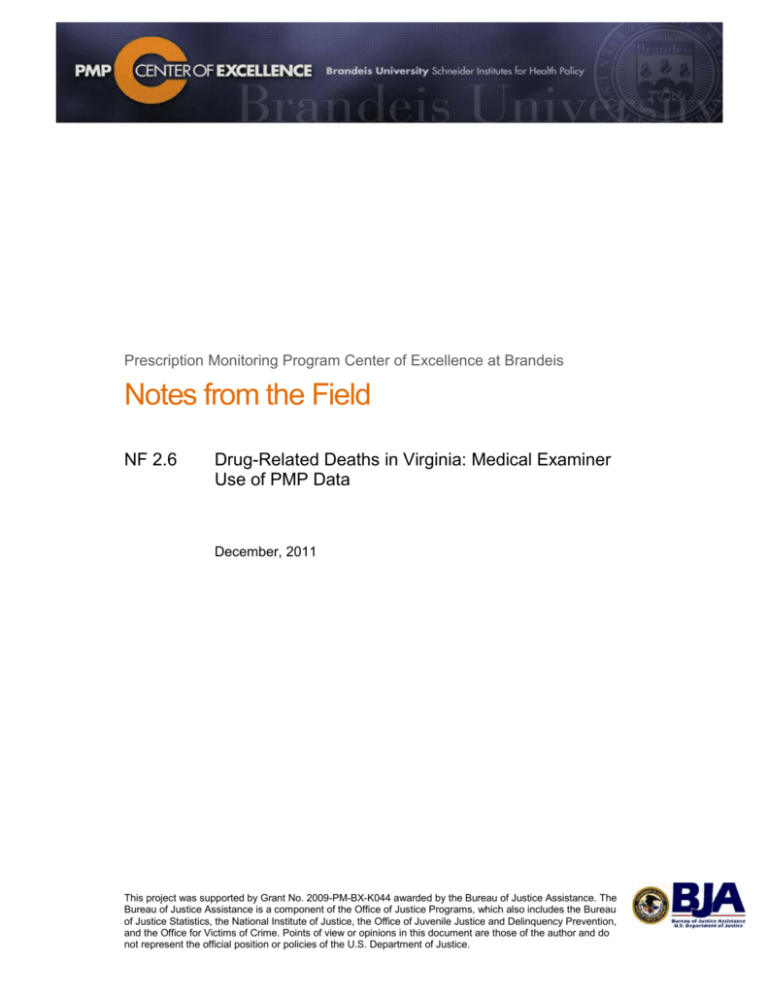
Prescription Monitoring Program Center of Excellence at Brandeis Notes from the Field NF 2.6 Drug-Related Deaths in Virginia: Medical Examiner Use of PMP Data December, 2011 This project was supported by Grant No. 2009-PM-BX-K044 awarded by the Bureau of Justice Assistance. The Bureau of Justice Assistance is a component of the Office of Justice Programs, which also includes the Bureau of Justice Statistics, the National Institute of Justice, the Office of Juvenile Justice and Delinquency Prevention, and the Office for Victims of Crime. Points of view or opinions in this document are those of the author and do not represent the official position or policies of the U.S. Department of Justice. Notes from the Field Drug-Related Deaths in Virginia: Medical Examiner Use of PMP Data Overview Deaths from abuse of prescription drugs, especially opioids, have increased markedly over the past decade in the United States. Medical examiners are beginning to use decedents’ prescription monitoring program (PMP) data to help determine whether and to what extent prescription drugs were a cause of death. This report describes the use of Virginia PMP data by an assistant medical examiner and her staff at Virginia’s Western District Medical Examiner’s Office. Her experience indicates that PMP data can assist in many phases of forensic investigations, both in the lab and in the field. Virginia’s example suggests that PMPs can play a valuable role in assisting medical examiners do their part in tracking and mitigating the prescription drug abuse epidemic. Background Unintentional drug overdose is now the leading cause of accidental death in the United States, having surpassed automobile accidents in 2009.1 Driving this trend is the sharp rise in the prescribing, diversion, and abuse of prescription medications such as opioids and benzodiazepines over the past decade. According to the Centers for Disease Control and Prevention, the number of unintentional overdose deaths per year involving opioid pain relievers (e.g., oxycodone and hydrocodone) nearly quadrupled from 1999 to 2007, rising from 2,900 to 11,500, while overdose deaths due to these drugs in 2007 were nearly twice those due to cocaine, and over 5 times those due to heroin.2 State medical examiners determining causes of death are tasked with investigating whether or not drugs played a role, and whether the death was intentional (suicide, homicide) or accidental (e.g., unintentional self-administered overdose). Statistics showing the rise in accidental prescription drug deaths reflect the collective professional judgment of medical examiners that overdoses were the primary cause of these deaths. The most conclusive evidence in such cases is a toxicology test showing potentially fatal concentrations of drugs or their metabolites in blood or tissue samples, taking into account the decedent’s individual circumstances and physical characteristics. For example, a dose fatal for an individual without a recent history of opioid use might be harmless for someone who has developed a physiological tolerance for opioids. This 1 This finding is from a Los Angeles Times analysis of data from the Centers for Disease Control and Prevention (article, data chart, interactive map). 2 For an overview of the prescription drug abuse epidemic, see http://www.pmpexcellence.org/drug-abuse-epidemic. 2 PMP Center of Excellence at Brandeis University www.pmpexcellence.org Virginia Medical Examiner Use of PMP Data means the decedent’s history of drug use bears on the determination of cause of death, should drugs be suspected. Data from prescription monitoring programs (PMPs) can shed light on prescription drug use since they describe an individual’s prescription history: specifically, when and what drugs were prescribed to them, by which prescribers, and dispensed by which pharmacies. Medical examiners in some states are now using PMP data to help guide autopsies and help frame hypotheses about likely causes of death. To illustrate the role of PMP data in medical examiner practice, this report draws on an interview with Virginia medical examiner Dr. Amy Tharp, who began requesting reports from the state’s PMP in 2007.3 Dr. Tharp is Assistant Chief Medical Examiner (ME) at the Virginia Office of the Chief Medical Examiner at Roanoke, in the state’s Western District. The most recent report from Virginia’s Chief Medical Examiners shows that in 2009 there were 527 accidental drug-related deaths in the state (at a rate of 6.4 per 100,000), compared with 829 deaths due to motor vehicle accidents (at a rate of 8.9 per 100,000).4 As described by Dr. Tharp, drug overdose deaths, many attributable to prescription drug abuse, present a particularly acute problem in Virginia’s more rural and mountainous Western District, which has approximately a quarter of Virginia’s population but one third of drug-related deaths. The Western District adjoins West Virginia and Kentucky, which have very high rates of drug-related deaths according to the Centers for Disease Control.5 There are indications, however, that prescription drug abuse and deaths are beginning to rise in eastern sections of Virginia, including the seaboard. Using PMP data in medical examiner practice According to Dr. Tharp, PMP data now play an important role in medical examiner practice in the Western District office. When she and other ME’s began using prescription history reports, they were requested only in cases of suspected drug overdose, but having proved their value they are now requested for all cases. Knowing a decedent’s prescription history can help in several aspects of a forensic investigation, as follows: 3 Guiding toxicology tests. PMP reports list drugs the decedent was prescribed, dispensed and perhaps used, so can suggest what drugs to screen for in toxicology tests. Absent a PMP report, certain drugs might be overlooked when running standard drug panels. By statute, the Virginia PMP permits medical examiner access to its data but not access by local coroners. 4 http://www.vdh.state.va.us/medExam/documents/2011/pdfs/AnnualReport09.pdf 5 http://www.cdc.gov/HomeandRecreationalSafety/pdf/poison-issue-brief.pdf 3 PMP Center of Excellence at Brandeis University www.pmpexcellence.org Virginia Medical Examiner Use of PMP Data 4 Guiding autopsies. Should the drugs listed in PMP reports raise the suspicion of a possible drug-related death, it may affect the types of samples collected for toxicology testing. Interpreting toxicology reports. The length of time a decedent was taking a drug (an opioid, for instance), can help explain why a certain observed blood concentration of the drug may have proved fatal. Individuals with no previous exposure to opioids are at greater risk for overdose, even at some medically approved dosages (e.g., for methadone). PMP data will show how long an individual was prescribed, dispensed and perhaps using opioids, and therefore can help estimate the level of tolerance at the time of death. Evidence of unnatural death. What might at first look like a natural death may prove to be drug-induced. Even if no other evidence suggesting drug use appears at the scene, and even if there are no obvious physical signs that a death is drug-induced, a PMP report showing recent prescriptions for possibly fatal quantities of drugs (e.g., opiates, barbiturates) or a pattern of prescriptions that may suggest “doctor shopping” will prompt further investigation. This will help rule in, or out, the possibility of unnatural death. Without PMP data, such an investigation might not have been carried out. Evidence of diversion. Being prescribed a drug is no guarantee that an individual has taken it, and the absence of certain classes of prescribed drugs in a toxicology report (e.g., opioids and other psychotropics) may suggest that the decedent was diverting drugs (e.g. selling the drugs), or otherwise failing to use them according to a doctor’s instructions. It may also indicate that drugs were stolen from the decedent. Alternatively, the presence in the body of a prescription drug for which the decedent did not obtain a prescription means he or she obtained them illicitly, from friends, family, associates or street dealers. Supplementing medical records. Medical records are sometimes incomplete or missing altogether. Moreover, medical records may show what drugs have been prescribed to a patient, but likely will not show what drugs were actually dispensed and therefore likely in the possession of the decedent in the days, weeks or months prior to death. PMP reports include both prescribing and dispensing information, available online up to a year in most states and, often, for longer periods by special request; records can be obtained for Virginia as far back as 2006 if needed. Aiding on-site forensic investigations. Since scenes of death are sometimes cleaned up by family or associates in advance of an investigation, pills or pill bottles originally at the scene may be withheld from police or other investigators. Sometimes investigators will fail to document or collect all drugs on the scene. PMP data can compensate for these possibilities by providing a snapshot of what drugs the decedent may have been using up to the time of death, even if no prescription drugs or containers are found or reported. Using a prescription history, investigators can estimate how many dosage units of a drug should have been found at the decedent’s premises, had he or she been using them according to prescriber instructions. PMP Center of Excellence at Brandeis University www.pmpexcellence.org Virginia Medical Examiner Use of PMP Data Contacting medical providers. PMP reports list those medical providers that prescribed drugs for the decedent, which greatly simplifies the job of contacting providers to obtain medical information. Prior to the PMP, investigators had to rely on next of kin and police for leads about which doctors were treating the decedent. Detecting prescription fraud. The ME’s office sometimes discovers via PMP reports that drugs are being prescribed and dispensed for deceased individuals; these cases are reported to the police for investigation. Procedures and safeguards Originally a fax-based system, the Virginia PMP went online in 2006 and continuous Web access with auto-response features became available in 2009. The Western District ME office takes full advantage of this capability, running PMP reports for all cases whenever they are needed, day or night. Reports are usually generated in advance of autopsies to assist medical examiners as described in the section above. Practitioners listed in the prescription history are contacted to obtain medical records and other information concerning the decedent’s reasons for being prescribed controlled substances. Dr. Tharp explained that all doctors and medical-legal death investigators (MDIs – those who conduct forensic field investigations) in the Western District office are authorized to log in to the PMP and download reports. As assistant ME, she supervises MDI use of the system. PMP reports are printed out and kept in secure files as part of case records. In Virginia, as in most states, PMP reports are treated as medical records: they are barred from release to 3rd parties without special permission. All authorized users are made aware that there are strict guidelines limiting access to and distribution of PMP data, and that there are significant penalties for any breach of data security. Improving PMPs As noted above, the Virginia PMP gradually upgraded from fax-transmitted reports to continuous online reporting. This dramatically improved access to data and sharply reduced the time required to generate reports, from days or hours to just seconds. This in turn facilitated the use of PMP data as a standard practice for the Western District office, with all the advantages such use entails. Dr. Tharp had further suggestions for improving PMPs and increasing the utility of their data for medical examiners and other users: 5 Make PMP reporting more timely. Many PMPs require that pharmacies only upload new prescription data bi-weekly. This means that drugs dispensed just before a patient died are not immediately available on PMP reports, but might appear in a report up to two weeks after a death, thus slowing down an investigation. This delay could be reduced were PMP data reported weekly or PMP Center of Excellence at Brandeis University www.pmpexcellence.org Virginia Medical Examiner Use of PMP Data daily, as in some states, or eliminated altogether by real time reporting as pioneered by Oklahoma’s PMP.6 Require physicians to enroll in the PMP and view PMP data on their patients as part of standard clinical practice. Awareness of their patients’ prescription history is important to ensure safe prescribing and good patient care, thus reducing the chances of fatal overdose or drug interactions, and it would reduce the chances of unnecessary prescribing for which a physician might be held liable. Encourage dentists to join and use the PMP. Dentists prescribe significant quantities of pain medications which are subject to abuse and diversion and should therefore be encouraged to access PMP data prior to making prescription decisions Make other state’s PMP data readily available to MEs via interstate data sharing. Those abusing or diverting controlled substances will often cross state lines to obtain multiple simultaneous prescriptions that won’t show up in a single state’s PMP database. For instance, a normal PMP report in Virginia doesn’t mean a decedent wasn’t receiving drugs in Kentucky, Tennessee, West Virginia or North Carolina. Regional reports combining neighbor states’ PMP data would simplify and accelerate the reporting process while providing a more complete picture of an individual’s prescription history. Conclusion Data from Virginia’s PMP are used by the state’s Western District Medical Examiner Office in many phases of death investigations, from guiding autopsies and toxicology tests to supplementing police searches and medical records. Because of their utility and wide application, PMP reports are now run for all cases and considered an indispensable investigative tool for medical examiners and their staff. Recent improvements to Virginia’s PMP have contributed to the expanded use of PMP data in medical examiner practice. Given the rise of prescription drug abuse and diversion over the last decade, medical examiner access to PMP data is crucial for the swift and reliable detection of these drugs as a cause of death, and to understanding the circumstances surrounding a fatal overdose. Medical examiner determinations of cause of death are essential in tracking the prescription drug abuse epidemic, and knowing a decedent’s prescription history is vital in making that determination. The experience of Virginia’s Western District office suggests that PMP data can play an important role in forensic investigations and can be smoothly integrated into medical examiner practice. Ω 6 Note here re our forthcoming report on OK real time reporting, or link to Don Vogt’s presentation if available. 6 PMP Center of Excellence at Brandeis University www.pmpexcellence.org Virginia Medical Examiner Use of PMP Data Note: For inquiries concerning this report, please contact the PMP Center of Excellence at Brandeis at www.pmpexcellence.org or call 781-736-3909. 7 PMP Center of Excellence at Brandeis University www.pmpexcellence.org

